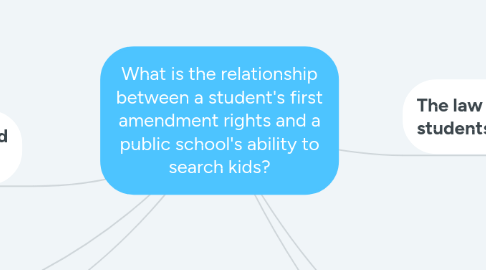
1. because content of the suspicion failed to match the degree of intrusion
2. Article 3 because
3. Schools can decide what and how they search.
3.1. In a major court case, the judge said that in order to keep schools safe, kids have to be searched (Robelen).
3.1.1. During a court case in 2009 about whether or not it is acceptable to strip-search students, "several of the justices seemed sympathetic to the challenges schools face in combating drug use" and the only question was "how far they might go in allowing administrators discretion to conduct strip-searches" (Roblen).
3.1.1.1. This makes me think that judges care more about catching drugs than they do about the well being of kids. They shouldn't humiliate people by strip-searching them.
3.1.2. In the same case, Justice Antonin Scalia said that schools should definitely be allowed to strip-search, saying that "if there is enough suspicion to search the outer garments of a student, it would follow that such suspicion would also merit a more intrusive search" (Roblen).
3.1.2.1. A lot of times, the "suspicion" is just what a person looks like or the color of their skin. If that much suspicion allows school officials to perform "intrusive" searches, where do we draw the line? This matters because students can be abused but officials can get away with it, saying they were looking for drugs.
3.2. keeping the schools safe is by strip searching students, and making sure they don't carry any drugs.
3.2.1. quote 3
3.2.1.1. this shows that
3.2.2. quote 4
3.2.2.1. this makes me think
4. Article 2 because
5. Because the supreme court decided that a school must have a clear reason to believe that a student has something dangerous in order to search them, and people can only be searched by people of the same gender.
6. The law limits searches and students have clear rights.
6.1. Summarize main idea 2
6.1.1. quote 1
6.1.1.1. what does this mean
6.1.2. quote 2
6.2. In a supreme court case that looked at student rights, a thirteen year old girl was searched by school officials for drugs. Because they searched her bra and underwear with no solid reason to do so, her rights were violated, according to the supreme court (Souter).
6.2.1. In talking about a 13-year-old girl who was strip-searched by school officials looking for drugs, Souter points out that it is "unreasonable for an educator of one gender to perform an invasive search of a student of the opposite gender, particular one involving removal of other than outer clothing like coats and hats" (Souter).
6.2.1.1. This matters because first of all, she didn't have drugs. Second, no child should be strip-searched. They should have called her mom if they were really worried about what she might have had on her.
6.2.2. In this case, at first the school administration did not recognize the one pill that the girl had. They called poison control and it was identified as "a 200-mg dose of an anti-inflammatory drug, generically called naproxen, available over the counter." Even though they knew she only had normal pain killers, she was still "subjected to a search of her bra and underpants" which turned up no other pills (Souter).
6.2.2.1. The girl had only common medicine. There was no reason for them to search her. But, they made her take her clothes off anyway. All kids everywhere have a right to basic privacy. Schools don't have a right to search a kid just because they have one pill of pain killers that anyone can buy at Kroger.

